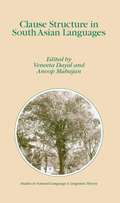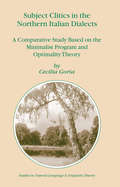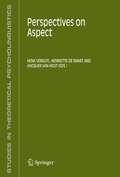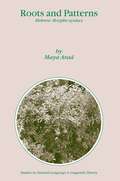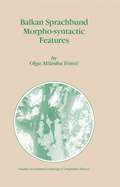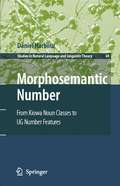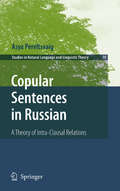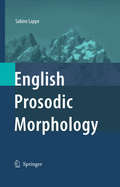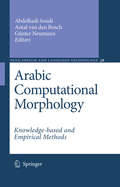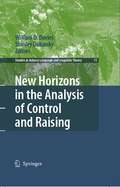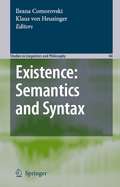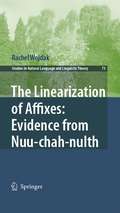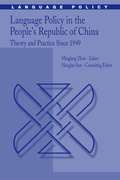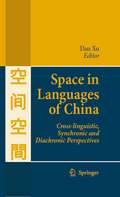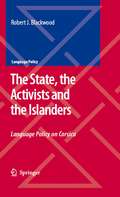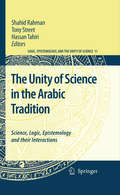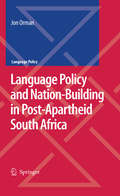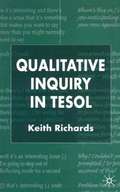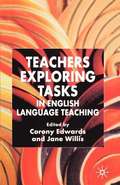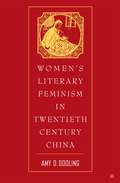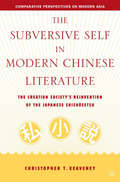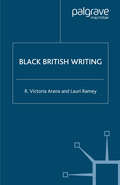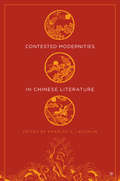- Table View
- List View
Clause Structure in South Asian Languages (Studies in Natural Language and Linguistic Theory #61)
by Anoop Mahajan V. DayalThe researchers in the field of theoretical and theoretically inclined descriptive linguistics have for a long time felt a need for detailed and clearly presented linguistic treatments of various syntactic phenomena in South Asian languages. Clause Structure in South Asian Languages: provides a comprehensive overview and covers major aspects of clause structure in a variety of South Asian languages; provides detailed analyses of several aspects of phrase structure of many prominent South Asian languages; gives theoretically up-to-date treatment of several important issues in South Asian syntax and semantics; contains papers by some of the most prominent linguists working on South Asian languages.
Subject Clitics in the Northern Italian Dialects: A Comparative Study Based on the Minimalist Program and Optimality Theory (Studies in Natural Language and Linguistic Theory #60)
by Cecilia Goria1. 0 INTRODUCTION This book provides an encompassing analysis of Subject Clitics (SCLs) by giving a detailed description of these elements in two varieties of Piedmontese, a Northern Italian Dialect: Astigiano and Turinese spoken in the areas of Asti and Turin respectively. It accounts for the structural position and function of these elements inside the computational system and for their morphological and distributional properties. It also provides an empirical and theoretical comparison between Piedmontese SCLs and SCLs in other Northern Italian Dialects (NIDs). of SCLs types in the NIDs have been regarded as Since the 1980s, the majority elements of agreement, in that they contribute to the realisation of subject verb agreement by expressing features of the subject similar, in a way, to verbal inflection. Nonetheless, SCLs are not to be assimilated to verbal affixes as they exhibit different properties. Most distinctively, they can be separated from the verb by other clitic elements and, in the case of the varieties considered here, SCLs are optional in all contexts and may be omitted in coordination. A more refined identification of SCLs separates SCLs which encode agreement features from those which do not and are related to pragmatic factors, as originally observed by Beninca (1994) with respect to the clitic a in Paduano The different morphological and syntactic properties that characterise SCLs across the NIDs have justified numerous accounts which regard them as head of their own projection.
Perspectives on Aspect (Studies in Theoretical Psycholinguistics #32)
by Henriette De Swart Angeliek Van Hout Henk J. VerkuylThis book offers both a retrospective view on how theories of aspectuality have developed over the past 30 years, and presents current, new directions of aspectuality research. The articles in this book take a wide crosslinguistic scope including aspectual analyses of the following languages: English and two varieties of English: African American English and Colloquial Singapore English, Italian, French, Bulgarian, Czech, Mandarin Chinese, West-Greenlandic, Wakashan languages, and Nahk-Daghestanian languages.
Roots and Patterns: Hebrew Morpho-syntax (Studies in Natural Language and Linguistic Theory #63)
by Maya AradIn-depth investigation of Hebrew verb morphology in light of cutting edge theories of morphology and lexical semantics An original theory about the semantic content of roots An account of how roots function in word-formation A wide empirical basis containing a complete corpus of verb-creating roots in Hebrew
Case and Linking in Language Comprehension: Evidence from German (Studies in Theoretical Psycholinguistics #34)
by Markus Bader Josef BayerBalkan Sprachbund Morpho-Syntactic Features (Studies in Natural Language and Linguistic Theory #67)
by Olga M. TomicThis book discusses the morpho-syntactic Balkan Sprachbund features in nine languages in which they are most numerous. It contains a wealth of Balkan linguistic material. The focus is on displaying similarities and differences in the representation of the most widely acknowledged Balkan Sprachbund morpho-syntactic features and their interaction with other features in the structure of the DP or the sentence of individual languages.
Morphosemantic Number: From Kiowa Noun Classes to UG Number Features (Studies in Natural Language and Linguistic Theory #69)
by Daniel HarbourNumber is a major research domain in semantics, syntax and morphology. However, no current theory of number is applicable to all three fields. In this work, the author argues that a unified theory is not only possible, but necessary for the study of Universal Grammar. Through insightful analysis of unfamiliar data, the author shows that one and the same feature set is implicated in semantic and morphological number phenomena alike, with syntax acting as the conduit between the two. At the heart of the study is an original treatment of Kiowa, a North American language with a remarkable constellation of characteristics, including semantically based noun classification and complex agreement morphology. This volume presents: (1) the foundations of a unified morphosemantic theory of number; (2) insight into the flow of information from the lexicon, via syntax, into the morphology; (3) wide-ranging topics: nominal semantics, noun classes, DP syntax, agreement, suppletion, complex morphology.
Code-switching in Bilingual Children (Studies in Theoretical Psycholinguistics #37)
by Katja F. CantoneThis volume demonstrates that mixed utterances in young bilinguals can be analyzed in the same way as adult code-switching. It provides new insights not only in the field of code-switching and of language mixing in young bilinguals, but also in issues concerning general questions on linguistic theory which are difficult to be answered with monolingual data.
Copular Sentences in Russian: A Theory of Intra-Clausal Relations (Studies in Natural Language and Linguistic Theory #70)
by Asya PereltsvaigThis book provides a detailed study and a novel Minimalist account of copular sentences in Russian, focusing on case marking alternations (nominative vs. instrumental) and drawing a distinction between two types of copular sentences. On the assumption that Merge is defined in the simplest way possible, it is argued that not all syntactic structures are a(nti)symmetrical. One of the copular sentence types is analyzed as a poster child for symmetrical structures, while the other type is treated as asymmetrical. The originality of this study lies in treating the copula in the two types of copular sentences neither as completely identical nor as two distinct lexical items; instead, the two types of copula are derived through the process of semantic bleaching. Furthermore, it is argued that the two types of the copula need to combine with post-copular phrases of different categories. It is concluded that Russian draws a distinction between saturated DPs and unsaturated NPs, in spite of its renowned lack of overt articles.
English Prosodic Morphology
by Sabine LappeLinguistic academics and speech therapists will find here the first modern book-length empirical study and theoretical account of English truncatory processes. On the basis of a corpus comprising some 3000 derivatives, the book provides a systematic investigation of the structural properties of six different patterns of English name truncation and word clipping. All patterns are shown to be unique in terms of the structural requirements that they impose on their outputs.
Arabic Computational Morphology: Knowledge-based and Empirical Methods (Text, Speech and Language Technology #38)
by Abdelhadi Soudi Günter Neumann Antal Van Den BoschThis is the first comprehensive overview of computational approaches to Arabic morphology. The subtitle aims to reflect that widely different computational approaches to the Arabic morphological system have been proposed. The book provides a showcase of the most advanced language technologies applied to one of the most vexing problems in linguistics. It covers knowledge-based and empirical-based approaches.
New Horizons in the Analysis of Control and Raising (Studies in Natural Language and Linguistic Theory #71)
by William D. Davies Stanley DubinskyRaising and control have figured in every comprehensive model of syntax for forty years. Recent renewed attention to them makes this collection a timely one. The contributions, representing some of the most exciting recent work, address many fundamental research questions. What beside the canonical constructions might be subject to raising or control analyses? What constructions traditionally treated as raising or control might not actually be so? What classes of control must be recognized? How do tense, agreement, or clausal completeness figure in their distribution? The chapters address these and other relevant issues, and bring new empirical data into focus.
Existence: Semantics and Syntax (Studies in Linguistics and Philosophy #84)
by Ileana Comorovski Klaus HeusingerThis collection of essays grew out of the workshop ‘Existence: Semantics and Syntax’, which was held at the University of Nancy 2 in September 2002. The workshop, organized by Ileana Comorovski and Claire Gardent, was supported by a grant from the Reseau ´ de Sciences Cognitives du Grand Est (‘Cognitive Science Network of the Greater East’), which is gratefully acknowledged. The ?rst e- tor wishes to thank Claire Gardent, Fred Landman, and Georges Rebuschi for encouraging her to pursue the publication of a volume based on papers presented at the workshop. Among those who participated in the workshop was Klaus von Heusinger, who joined Ileana Comorovski in editing this volume. Besides papers that developed out of presentations at the workshop, the volume contains invited contributions. We are grateful to Wayles Browne, Fred Landman, Paul Portner, and Georges Rebuschi for their help with reviewing some of the papers. Our thanks go also to a Springer reviewer for the careful reading of the book manuscript. We wish to thank all the participants in the workshop, not only those whose contributions appear in this volume, for making the workshop an int- active and constructive event. Ileana Comorovski Klaus von Heusinger vii ILEANA COMOROVSKI AND KLAUS VON HEUSINGER INTRODUCTION The notion of ‘existence’, which we take to have solid intuitive grounding, plays a central role in the interpretation of at least three types of linguistic constructions: copular clauses, existential sentences, and (in)de?nite noun phrases.
The Linearization of Affixes: Evidence from Nuu-chah-nulth (Studies in Natural Language and Linguistic Theory #73)
by Rachel WojdakThis book examines the problem of linearization from a new perspective: that of the linearization of affixes. The author’s driving proposition is that affixation provides a means of satisfying the universal requirement to linearize linguistic outputs. This proposition is tested using original data from Nuu-chah-nulth ("Nootka"; Wakashan family), an endangered Amerindian language that is remarkable for its complex morphology.
Language Policy in the People’s Republic of China: Theory and Practice Since 1949 (Language Policy #4)
by Minglang Zhou Hongkai SunLanguage matters in China. It is about power, identity, opportunities, and, above all, passion and nationalism. During the past five decades China’s language engineering projects transformed its linguistic landscape, affecting over one billion people’s lives, including both the majority and minority populations. The Han majority have been juggling between their home vernaculars and the official speech, Putonghua - a speech of no native speakers - and reading their way through a labyrinth of the traditional, simplified, and Pinyin (Roman) scripts. Moreover, the various minority groups have been struggling between their native languages and Chinese, maintaining the former for their heritages and identities and learning the latter for quality education and socioeconomic advancement. The contributors of this volume provide the first comprehensive scrutiny of this sweeping linguistic revolution from three unique perspectives. First, outside scholars critically question the parities between constitutional rights and actual practices and between policies and outcomes. Second, inside policy practitioners review their own project involvements and inside politics, pondering over missteps, undergoing soul-searching, and theorizing their personal experiences. Third, scholars of minority origin give inside views of policy implementations and challenges in their home communities. The volume sheds light on the complexity of language policy making and implementing as well as on the politics and ideology of language in contemporary China.
Space in Languages of China: Cross-linguistic, Synchronic and Diachronic Perspectives
by Dan XuSpace has long been a popular topic in linguistic research. Numerous books on the subject have been published over the past decade. However, none of these books were based on linguistic data from Chinese and expressions of space in Chinese have been largely neglected in past research. In this volume, not only Mandarin Chinese (the standard language) is investigated; several other dialects, as well as a minority language of China and Chinese Sign Language are studied. Cross-linguistic, synchronic and diachronic approaches are used to investigate phenomena related to space. The authors of this book present different points of view on the expression of space in language and related theoretical issues. As the contributing scholars argue, Chinese shares many common features with other languages, but also presents some particular properties. Space is a topic that is both classical and modern, of enduring interest. These studies of space give insight into not only general linguistics but also other domains such as anthropology and psychology.
The State, the Activists and the Islanders: Language Policy on Corsica (Language Policy #8)
by Robert J. BlackwoodThis analysis of language policy on Corsica provides the first study of the three levels of language policy existing on the Mediterranean island of Corsica. It focuses on the key participants - the State, the language activists and the islanders - in the language debate that has taken place across the island since its purchase by France. This book is informed by recent work on language planning, both theoretical and relating to specific case studies. At the same time, it engages with trends in sociolinguistics over the past decades, which have included language planning in their investigations of languages in contact, language obsolescence and language death. A central premise of this book is that the three discrete categories of participants in the language debate are closely interrelated and that the status and position of Corsican in relation to French cannot be understood without a thorough exploration of these three strands. This volume will appeal to researchers and students in French Studies, sociolinguistics, and especially language policy.
The Unity of Science in the Arabic Tradition: Science, Logic, Epistemology and their Interactions (Logic, Epistemology, and the Unity of Science #11)
by Shahid Rahman Tony Street Hassan Tahirithe demise of the logical positivism programme. The answers given to these qu- tions have deepened the already existing gap between philosophy and the history and practice of science. While the positivists argued for a spontaneous, steady and continuous growth of scientific knowledge the post-positivists make a strong case for a fundamental discontinuity in the development of science which can only be explained by extrascientific factors. The political, social and cultural environment, the argument goes on, determine both the questions and the terms in which they should be answered. Accordingly, the sociological and historical interpretation - volves in fact two kinds of discontinuity which are closely related: the discontinuity of science as such and the discontinuity of the more inclusive political and social context of its development. More precisely it explains the discontinuity of the former by the discontinuity of the latter subordinating in effect the history of science to the wider political and social history. The underlying idea is that each historical and - cial context generates scientific and philosophical questions of its own. From this point of view the question surrounding the nature of knowledge and its development are entirely new topics typical of the twentieth-century social context reflecting both the level and the scale of the development of science.
Language Policy and Nation-Building in Post-Apartheid South Africa (Language Policy #10)
by Jon OrmanThe preamble to the post-apartheid South African constitution states that ‘South Africa belongs to all who live in it, united in our diversity’ and promises to ‘lay the foundations for a democratic and open society in which government is based on the will of the people and every citizen is equally protected by law’ and to ‘improve the quality of life of all citizens’. This would seem to commit the South African government to, amongst other things, the implementation of policies aimed at fostering a common sense of South African national identity, at societal dev- opment and at reducing of levels of social inequality. However, in the period of more than a decade that has now elapsed since the end of apartheid, there has been widespread discontent with regard to the degree of progress made in connection with the realisation of these constitutional aspirations. The ‘limits to liberation’ in the post-apartheid era has been a theme of much recent research in the ?elds of sociology and political theory (e. g. Luckham, 1998; Robins, 2005a). Linguists have also paid considerable attention to the South African situation with the realisation that many of the factors that have prevented, and are continuing to prevent, effective progress towards the achievement of these constitutional goals are linguistic in their origin.
Qualitative Inquiry In TESOL (PDF)
by Keith RichardsGraduate and professional TESOL students will welcome this research methods textbook for undertaking qualitative, naturalistic and action research projects. Uniquely, the book offers a three-level structured progression, suited both to novice and intermediate students with a focus on development as classroom teachers of English, and to advanced students engaged in academic research work in applied linguistics. Every chapter is structured to develop the important skills for undertaking QI in a rigorous and serious way, at whatever level is appropriate for the reader's purpose. The book is both scholarly in approach and written in an engagingly direct and clear style.
Teachers Exploring Tasks In English Language Teaching (PDF)
by Corony Edwards Jane WillisWinner - British Council Innovation in English Language Teaching Award 2006 This book was written for language teachers by language teachers, with a view to encouraging readers to use more tasks in their lessons, and to explore for themselves various aspects of task-based teaching and learning. It gives insights into ways in which tasks can be designed, adapted and implemented in a range of teaching contexts and illustrates ways in which tasks and task-based learning can be investigated as a research activity. Practising language teachers and student professionals on MA TESOL/Applied Linguistics courses will find this a rich resource of varied experience in the classroom and a stimulus to their own qualitative studies.
Women’s Literary Feminism in Twentieth-Century China
by A. DoolingThis is a critical inquiry into the connections between emergent feminist ideologies in China and the production of 'modern' women's writing from the demise of the last imperial dynasty to the founding of the PRC. It accentuates both well-known and under-represented literary voices who intervened in the gender debates of their generation as well as contextualises the strategies used in imagining alternative stories of female experience and potential. It asks two questions: first, how did the advent of enlightened views of gender relations and sexuality influence literary practices of 'new women' in terms of narrative forms and strategies, readership, and publication venues? Second, how do these representations attest to the way these female intellectuals engaged and expanded social and political concerns from the personal to the national?
The Subversive Self in Modern Chinese Literature: The Creation Society’s Reinvention of the Japanese Shishôsetsu (Comparative Perspectives on Modern Asia)
by C. KeaveneyAn examination of whether Chinese writers of the Creation Society, a Chinese literary coterie, successfully appropriated shishosetsu, a quintessentially Japanese form of autobiographical narrative, into a form to be exploited for their own ends, especially political ends.
Black British Writing
by Lauri RameyThis collection of essays provides an imaginative international perspective on ways to incorporate black British writing and culture in the study of English literature, and presents theoretically sophisticated and practical strategies for doing so. It offers a pedagogical, pragmatic and ideological introduction to the field for those without background, and an integrated body of current and stimulating essays for those who are already knowledgeable. Contributors to this volume include scholars and writers from Britain and the U.S. Following on recent developments in African American literature, postcolonial studies and race studies, the contributors invite readers to imagine an enhanced and inclusive British canon through varied essays providing historical information, critical analysis, cultural perspective, and extensive annotated bibliographies for further study.
Contested Modernities in Chinese Literature
by C. LaughlinThis book is a significant gathering of ideas on the subject of modern Chinese literature and culture of the past several years. The essays represent a wide spectrum of new approaches and new areas of subject matter that are changing the landscape of knowledge of modern and contemporary Chinese culture: women's literature, theatre (performance), film, graphic arts, popular literature, as well as literature of the Chinese diaspora. These phenomena and the approaches to them manifest interconnected trajectories for new scholarship in the field: the rewriting of literary history, the emergence of visual culture, and the quotidian apocalypse - the displacement of revolutionary romanticism and realism as central paradigms for cultural expression by the perspective of private, everyday experience.
